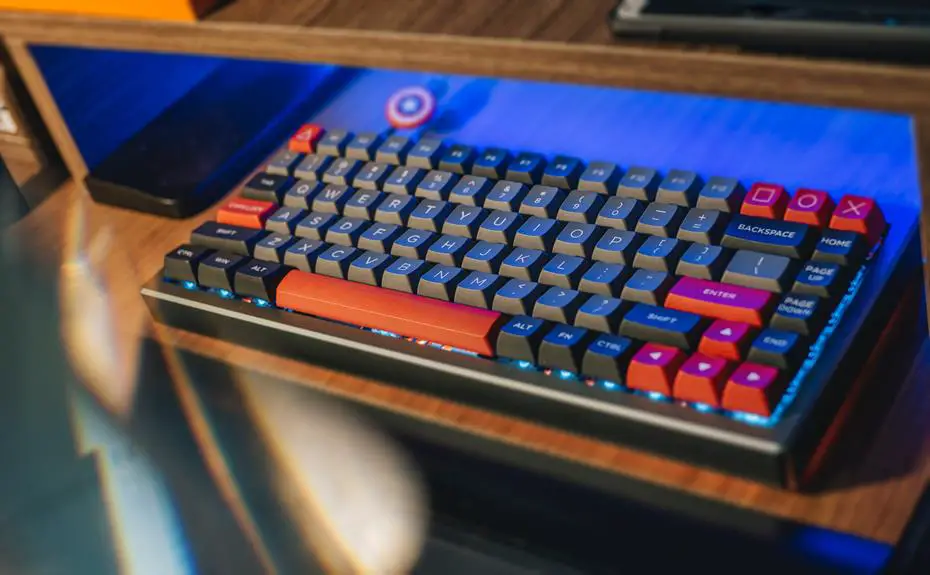Hey there!
When it comes to setting up your home office, it's crucial to nail down the essentials for maximum productivity. One key element you might not have considered is your mechanical keyboard. Understanding which parts are essential can make a world of difference in your daily work grind.
From the layout options to the switch types and feel, each component plays a role in your typing experience. Backlighting, keycap material, and ergonomic design are also factors to consider for a top-notch setup.
So, let's dive in and explore which parts of a mechanical keyboard are essential for your home office mastery.
Key Takeaways
- Wireless connectivity and compact size are essential for optimizing workspace in a home office.
- Choosing the right switch type and feel (clicky, tactile, linear, or silent) is crucial for aligning with typing preferences.
- Customizable backlighting and programmable keys enhance visibility and create a comfortable and visually appealing work environment.
- Keycap material and profile (such as PBT or ABS) play a vital role in providing durability, resilience to wear and tear, and a smoother typing experience.
Keyboard Layout Options
The keyboard layout options available for your home office setup can greatly impact your typing experience and efficiency. When selecting a keyboard, consider factors such as wireless connectivity and compact size to optimize your workspace.
Wireless keyboards offer the freedom of movement, reducing clutter and allowing for a more flexible office arrangement. Additionally, a compact size can save valuable desk space, promoting a streamlined and organized work environment.
For ergonomic benefits, explore split keyboard options. These keyboards are designed to promote a more natural hand position, reducing strain and discomfort during extended typing sessions. Furthermore, programmable keys can enhance your productivity by allowing you to customize shortcuts and commands tailored to your specific work tasks. This customization can lead to time savings and a smoother workflow, making your home office experience more efficient and enjoyable.
Switch Types and Feel
Considering the switch types and feel is crucial when selecting a mechanical keyboard for your home office setup. The switch type determines the way a keypress is registered, affecting the tactile feedback, audible sound, actuation point, and travel distance. It's essential to choose a switch type that aligns with your typing preferences and working environment. Here's a comparison of some common switch types:
| Switch Type | Tactile Feedback | Audible Sound | Actuation Point | Travel Distance |
|---|---|---|---|---|
| Clicky | Yes | Yes | High | Medium |
| Tactile | Yes | No | Medium | Medium |
| Linear | No | No | Low | Short |
| Silent | Yes | No | Medium | Medium |
Clicky switches provide tactile feedback and an audible clicking sound, making them suitable for those who prefer a distinctive typing feel. Tactile switches offer tactile feedback without the audible click, providing a quieter typing experience. Linear switches have a smooth keystroke without tactile feedback, ideal for fast typists. Silent switches combine tactile feedback with reduced audible sound, making them suitable for shared workspaces. By understanding these switch types, you can make an informed decision to enhance your typing experience in your home office.
Backlighting and Customization
When setting up your home office with a mechanical keyboard, selecting a model with customizable backlighting and programmable keys can significantly enhance your workspace productivity. The ability to customize the color options and effects of the backlighting not only adds a personal touch to your setup but also allows for better visibility in dimly lit environments. Custom keymapping and macros further elevate your efficiency by enabling you to assign specific functions or commands to keys, streamlining your workflow and reducing repetitive tasks.
With color options and effects, you can create a comfortable and visually appealing work environment, which is essential for long hours spent typing. Additionally, being able to customize the backlighting to match your preferences or even sync it with other devices can contribute to a cohesive and aesthetically pleasing workspace.
Custom keymapping and macros give you the power to tailor your keyboard to your specific needs, allowing you to execute complex commands with a single keystroke. This level of customization not only saves time but also reduces the risk of errors, ultimately increasing your overall productivity.
When choosing a mechanical keyboard for your home office, prioritizing backlighting and customization options will undoubtedly contribute to a more efficient and enjoyable work experience.
Keycap Material and Profile
Selecting keycaps made from durable materials, such as PBT or ABS, is crucial for ensuring longevity and comfort in your daily typing tasks. Keycap material durability directly impacts the lifespan of your keyboard, as well as the feel of the keys during use.
PBT keycaps are known for their resilience to wear and tear, making them a popular choice among keyboard enthusiasts. On the other hand, ABS keycaps, while not as durable as PBT, offer a smoother and more comfortable typing experience due to their softer texture.
When it comes to keycap profile comfort, the shape and height of the keycaps play a significant role in determining how comfortable and ergonomic your typing experience will be. Keycap profiles such as OEM, Cherry, DSA, and SA each offer a unique feel and typing experience, allowing you to customize your keyboard to suit your preferences.
Ergonomic Design Considerations
To optimize comfort and reduce strain during extended typing sessions, prioritizing ergonomic design in your mechanical keyboard setup is crucial. Wrist support is essential for maintaining a comfortable typing posture and reducing hand strain. When selecting a mechanical keyboard, consider features such as a wrist rest or an ergonomic design that promotes a more natural hand position. Look for keyboards that offer adjustable tilt and height settings to customize the typing angle for your comfort. Additionally, keyboards with cushioned palm supports can help alleviate pressure on the wrists and enhance overall comfort during prolonged use.
Typing posture plays a significant role in reducing hand strain. Look for keyboards with a design that encourages a neutral wrist position to minimize stress on the muscles and tendons. A split keyboard layout or an ergonomic curvature can promote a more relaxed hand position, reducing the risk of repetitive strain injuries.
Prioritizing ergonomic design considerations in your mechanical keyboard selection can significantly impact your comfort and long-term typing experience.
Frequently Asked Questions
Can I Use a Mechanical Keyboard With a Wireless Connection in My Home Office?
Yes, you can use a mechanical keyboard with wireless connectivity in your home office. It offers you the flexibility to work without being tethered to your desk. Look for one with an ergonomic design for added comfort.
Are Mechanical Keyboards Compatible With All Operating Systems?
Yes, mechanical keyboards are compatible with all operating systems. They offer excellent gaming performance, various switch types for a customized feel, and ergonomic designs to reduce strain during long typing sessions.
How Do I Clean and Maintain a Mechanical Keyboard for Optimal Performance in a Home Office Setting?
To keep your mechanical keyboard in top shape for your home office, regular cleaning and preventive maintenance are key. Use gentle cleaning methods like compressed air and a keycap puller to remove dirt and debris. Preventive maintenance can prolong its lifespan.
Are There Any Specific Recommendations for Using a Mechanical Keyboard in a Home Office to Minimize Noise for Others in the Household?
To minimize noise in your home office, consider using keyboard accessories like dampening rings or o-rings. Also, an ergonomic setup with a wrist rest can help reduce keystroke noise and improve your typing experience.
Can I Customize the Function of Specific Keys on a Mechanical Keyboard for Specific Tasks in My Home Office?
Absolutely! You can customize the function of specific keys on a mechanical keyboard for specific tasks in your home office. This not only enhances your typing experience but also allows for noise reduction. Key customization is key!




